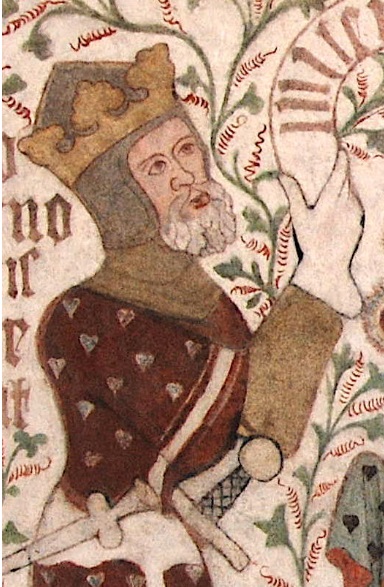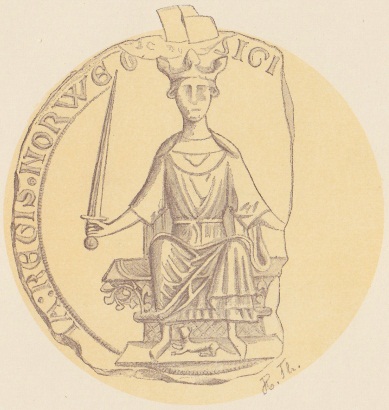by Susan Flantzer
© Unofficial Royalty 2025

Effigy of Margrethe I, Queen of Denmark, Norway, and Sweden; Credit – Wikipedia
I first came across Margrethe I, Queen of Denmark, Norway, and Sweden in 2011, when I visited Roskilde Cathedral in Roskilde, Denmark, the burial site of most Danish monarchs and their spouses. Her tomb there with its beautiful effigy and wonderful carvings is my favorite royal tomb. The founder of the Kalmar Union which united the three kingdoms of Denmark, Norway, and Sweden under a single monarch from 1397 – 1523, Margrethe I, Queen of Denmark, Norway, and Sweden was called “the first great ruling queen in European history” by Norwegian-American author, historian, and college professor Knut Gjerset.
Margrethe held various titles at certain points during her life:
- Queen Consort of Sweden: 1363 – 1364
- Queen Consort of Norway: 1363 – 1380
- Regent of Denmark (for her son): 1376 – 1387
- Regent of Norway (for her son): 1380 – 1387
- Sovereign Queen of Denmark: 1387 – 1412
- Sovereign Queen of Norway: 1388 – 1412
- Sovereign Queen of Sweden: 1389 – 1412

Margrethe’s father Valdemar IV, King of Denmark; Credit – Wikipedia
The youngest of the six children and the youngest of the four daughters of Valdemar IV, King of Denmark and Helvig of Schleswig, Margrethe was born in March 1353 in Søborg Castle in Denmark.
Margrethe had five elder siblings but at the time of her birth, three siblings had died.
- Christoffer of Denmark, Duke of Lolland (1341 – 1363), unmarried, died at age 22
- Margrethe of Denmark (1345 – 1350), died in childhood
- Ingeborg of Denmark (1347 – 1370); married Heinrich III, Duke of Mecklenburg, had three daughters and one son
- Katrine of Denmark (born and died 1349); died in infancy
- Valdemar Denmark (born and died 1350); died in infancy

Margrethe’s mother Queen Helvig; Credit – Wikipedia
Margrethe grew up at her father’s court at his many castles including Copenhagen Castle, Søborg Castle, Vordingborg Castle, Kalundborg Castle, Roskilde Castle, and his hunting seat Gurre Castle. In 1355, Margrethe’s mother Queen Helvig entered Esrum Abbey as a lay sister after being replaced by her husband’s mistress Tove. Queen Helvig died circa 1374 and was buried at Esrum Abbey.

Seal of King Haakon VI of Norway; Credit – Wikipedia
In 1359, King Valdemar IV of Denmark betrothed his six-year-old daughter Margrethe to eighteen-year-old King Haakon VI of Norway, a younger son of Magnus Eriksson, King of Norway and Sweden, as part of an alliance treaty. Margrethe and King Haakon VI were married at Copenhagen Cathedral in Denmark on April 9, 1363.
When Margrethe’s husband Haakon was born, his father Magnus Eriksson, King of Norway and Sweden decided to divide his kingdoms between his sons. The elder son Eric was designated to succeed his father as King of Sweden, while Haakon would become King of Norway. By 1343, three-year-old Haakon had become King of Norway. Opposition to Magnus’ rule in Norway led to an agreement between Magnus and the Norwegian nobles. In violation of the Norwegian laws on royal inheritance, Haakon would become King of Norway, with Magnus as regent during his minority. In 1344, five-year-old Eric was formally elected King of Sweden and co-reigned with his father. Three years after Eric died in 1359, Haakon became co-ruler of Sweden with his father. The two reigned over Sweden together until 1364, when they were deposed in favor of Magnus’ nephew, Albert III, Duke of Mecklenburg by a group of exiled Swedish noblemen. Magnus and Haakon tried to retake the Swedish throne but were unsuccessful.

Akershus Fortress in Oslo, Norway where Margrethe spent the early years of her marriage; Credit – By Ghirlandajo – Own work, CC BY-SA 4.0, https://commons.wikimedia.org/w/index.php?curid=42021733
Ten-year-old Margrethe remained in Denmark for some time after the wedding. Eventually, she moved to Norway and lived primarily at Akershus Fortress in Oslo. Margrethe was too young for the marriage to be consummated. Her governess was Swedish noblewoman Merete Ulvsdatter, a daughter of Saint Birgitta of Sweden. Margrethe was raised with Merte Ulvsdatter’s daughters Ingegerd and Katrine, who became her closest friends. She spent her time getting acclimated to Norway and preparing for her duties as Queen Consort.
Margrethe and Haakon VI had one son who was born at Akershus Fortress in Oslo, Norway:
- Olaf II, King of Denmark/Olaf IV, King of Norway (1370 – 1387), unmarried, died in his teens

Margrethe’s son Olaf who was King of Denmark and King of Norway; Credit – Wikipedia
Margrethe’s father Valdemar IV, King of Denmark died on October 24, 1375, and Margrethe was the only survivor of his six children. It was expected that Duke Albert IV of Mecklenburg, the son of Ingeborg of Denmark, Valdemar IV’s eldest child who survived childhood and had children, would claim the Danish throne. However, Margrethe managed to win over the Danish royal council by offering them lucrative grants and agreements. She also won the support of the Hanseatic League, a commercial and defensive network of merchant guilds and market towns in central and northern Europe, which did not want the House of Mecklenburg to gain power in Denmark. On May 3, 1376, Margrethe’s five-year-old son Olaf was proclaimed King of Denmark with his mother Margrethe acting as Regent of Denmark because of her son’s young age. A little more than four years later, on September 11, 1380, Margrethe’s husband King Haakon VI of Norway died. Their ten-year-old son Olaf was now also King of Norway, and his mother Margrethe was also Regent of Norway. With Olaf’s accession to the throne of Norway, 434 years of a Danish-Norwegian union began.
On August 3, 1387, Margrethe’s sixteen-year-old son Olaf II, King of Denmark/Olaf IV, King of Norway died. He was buried at Sorø Abbey, a Benedictine Abbey on the island of Zealand in Denmark, where Margrethe’s father King Valdemar IV of Denmark was buried. There were unproven rumors that Olaf was poisoned. In 2015, Jørgen Lange Thomsen, a forensic scientist, proposed a theory Olaf died from Brugada Syndrome, a genetic disorder. See Copenhagen Post: Mystery of Danish king deaths fosters new theory.
During her son’s reign, Margrethe had been a very capable Regent of Denmark and Norway. After her son’s death, she used all her diplomatic skills and was named Queen of Denmark on August 10, 1387, and Queen of Norway on February 2, 1388. Margrethe joined forces with the Swedish nobles who rose against the unpopular King Albert of Sweden, Haakon’s cousin who had taken the Swedish throne in 1364, when he attempted to reduce the land holdings of the Swedish nobility. At a meeting at Dalaborg Castle in Sweden in March 1388, the Swedish nobles proclaimed Margrethe to be Sweden’s “sovereign lady and rightful ruler”. Margrethe sent troops to Sweden and on February 24, 1389, they defeated King Albert of Sweden at the Battle of Åsle.

Statue of Queen Margrethe I and her great-nephew Eric of Pomerania in Viborg, Denmark; Credit – By Oleryhlolsson – Own work, CC BY-SA 4.0, https://commons.wikimedia.org/w/index.php?curid=86745447
Because Queen Margrethe I had no living children, she adopted her great-nephew Eric of Pomerania (Unofficial Royalty article coming). When Eric came of age, he was declared co-ruler in Denmark, Norway, and Sweden, however, Margarethe remained the effective ruler of all three kingdoms for the remainder of her life.
Margrethe devised the Kalmar Union, a personal union from 1397 to 1523, in which a single monarch ruled the three kingdoms of Denmark, Sweden (then including much of present-day Finland), and Norway, together with Norway’s overseas colonies (then including Iceland, Greenland, the Faroe Islands, and the Northern Isles of Orkney and Shetland).
Margrethe was in constant conflict with the neighboring Duchy of Schleswig. In 1412, Margrethe successfully took the border city of Flensburg, then in the Duchy of Schleswig, now in the German state of Schleswig-Holstein. In October 1412, Margrethe and her co-ruler and great-nephew Eric set sail to Flensburg to have the local citizens swear an oath of loyalty to them. After attending several meetings, Margrethe boarded her ship docked in the Flensburg harbor intending to set sail back to Denmark. However, she suddenly became violently ill. Suspecting that she was dying, Margrethe ordered thirty-seven marks to be paid to a nearby monastery for perpetual Masses for her soul. On October 28, 1412, 59-year-old Margrethe died aboard her ship docked in Flensburg harbor. Several possible causes of Margrethe’s death have been discussed over the years including the bubonic plague and poisoning by her co-ruler and great-nephew Eric, who became sole King of Denmark, Norway, and Sweden when Margrethe died.

Roskilde Cathedral where Queen Margrethe I is buried; Photo Credit © Susan Flantzer
Queen Margrethe I wished to be buried at Sorø Abbey, a Benedictine abbey on the island of Zealand in Denmark where her father King Valdemar IV of Denmark and her son Olaf II, King of Denmark/Olaf IV, King of Norway were buried. In 1413, the year after she died, Peder Jensen Lodehat, Bishop of Roskilde ordered her remains to be transferred to Roskilde Cathedral in Roskilde, Denmark, probably to give Roskilde Cathedral greater importance. There were several earlier royal burials at Roskilde Cathedral. Harald Bluetooth, King of Denmark and Norway (died circa 985 – 986), who introduced Christianity to Denmark, was buried at the Holy Trinity Church, the wooden, first church on the site where Roskilde Cathedral now stands. His son Sweyn Forkbeard, King of Denmark, Norway, and England (963 – 1014) was first buried in England and his remains were later moved to Denmark where they were interred near his father at the Holy Trinity Church. However, their tombs have never been found. Sweyn II Ertridsen, King of Denmark (1019 – 1076) was interred in the southeastern pier of Roskilde Cathedral. A pier is similar to a column and is designed to support arches.

Tomb of Margrethe I; Photo Credit © Susan Flantzer
Queen Margrethe I was interred in a sarcophagus behind the high altar. Her beautiful sarcophagus was made by German sculptor Johannes Junge (link in German) in 1423. The sarcophagus is made of black marble. On the sarcophagus is a life-sized effigy of Queen Margrethe I made of white alabaster. The reliefs on the sides of the sarcophagus are also made of white alabaster. Margrethe left property to Roskilde Cathedral on the condition that Masses for her soul would be said regularly in the future. This was discontinued in 1536 during the Protestant Reformation although a special bell is still rung twice daily in memory of Queen Margrethe I.
This article is the intellectual property of Unofficial Royalty and is NOT TO BE COPIED, EDITED, OR POSTED IN ANY FORM ON ANOTHER WEBSITE under any circumstances. It is permissible to use a link that directs to Unofficial Royalty.
Works Cited
- Autoren der Wikimedia-Projekte. (2006). Margarethe I. (1353-1412). Wikipedia.org; Wikimedia Foundation, Inc. https://de.wikipedia.org/wiki/Margarethe_I.
- Bidragsydere til Wikimedia-projekter. (2003). Margarete I Regent af Danmark 1375-1412. Wikipedia.org; Wikimedia Foundation, Inc. https://da.wikipedia.org/wiki/Margrete_1.
- Flantzer, Susan. Danish Royal Burial Sites. (2012). Unofficial Royalty. https://www.unofficialroyalty.com/royal-burial-sites/danish-royal-burial-sites/
- Flantzer, Susan. (2025). Olaf II, King of Denmark/Olaf IV, King of Norway. Unofficial Royalty. https://www.unofficialroyalty.com/olaf-ii-king-of-denmark-olav-iv-king-of-norway/
- Flantzer, Susan. (2021). Roskilde Cathedral in Roskilde, Denmark. Unofficial Royalty. https://www.unofficialroyalty.com/roskilde-cathedral-in-roskilde-denmark/
- Margaret I of Denmark. (2023). Wikipedia. https://en.wikipedia.org/wiki/Margaret_I_of_Denmark
- Wikipedia Contributors. (2024). Haakon VI. Wikipedia; Wikimedia Foundation.
